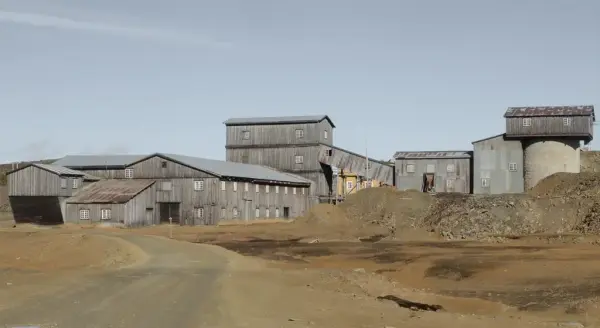-
The floatation works at Lower Storwartz Jon Holm Lillegjelten
This mine was fully working until the early part of the 1700s, and occasionally after that time. There are still many relics to be seen in the area to remind us of the activity that took place here, the traces of firing up in Cornelia Shaft and stone dropped during hand carrying and horse drawn transportation of ore out of the mines.
The profit from Gamle Storwartz varied a great deal, but the discovery of that rich ore led to intensive prospecting in the surrounding area. In 1650 work was started at Nyberget mine, and in 1659 Hestkletten was started. In addition, Christianus Qvintus was started in 1691 and Myrgruva in 1694. The two last mentioned were eventually amalgamated into one large mine, and for a time was considered to be the Company’s main mine. Nyberget mine was closed down in 1717 and Hestkletten closed in 1756 and Qvintus continued until 1770. However, all the mines were re-opened at later times and Nyberget had a new lease of life between 1870 and 1890. It was assumed that the mine had lodes running both north and south, and in 1936 the continuation lode to the north was found. This became the youngest mine in the Storwartz field known as the Crown Prince Olav Mine and it was worked until 1972. Nyberget and Olavgruva are today the Røros Museum’s where visitors are allowed, and, wandering through the two mines gives an impression of both old and modern mining methods.
East of Nyberget copper ore was discovered in 1673. The discovery was very welcome as during the same year the Company lost enormous supplies of charcoal and wood, which caught fire and were destroyed and led to economic difficulties. The new discovery was therefore named Solskinn, (Sunshine) as it gave hope for better times to come for the Copper Works. Sunshine was however, short-lived. By 1690 Gamle Solskinn (Old Sunshine) had been producing poorly for a long time, but the mine was not finally closed down until 1730. In 1854 a new discovery of copper was made in the same area, which was given the name, New Sunshine Mine and the horizontal level into the mine led to the re-opening of Nyberget mine in 1861. In 1870 Old Sunshine was re-opened but only to be closed down again in 1890.
Nye Storwartz became the Company’s main mine with continuous production for almost 250 years. After Gamle Storwartz had run with a loss for considerable time a new strike was made in an area north east of the old discovery. Mining was quickly started at the strike, and in 1711 the mine was first referred to as Nye Storwartz mine. In the same year the workers’ barracks was moved to the new mine. Hopes were high. But here, the results were variable. But in 1779 Nye Storwartz …’was the only mine one could rely on’. (Dahle, 1894: page 218). This mine continued in operation until 1946.
The fact that profits from the mine were variable had several reasons. In some cases the quality of the copper ore did not pay, in other instances poor extraction was the reason. The Company was continuously searching for new methods and technology to improve the breaking of rock. New methods of blasting and improved lifting systems, as well as better methods of crushing helped to improve the extraction process. The introduction of the contract system for payments also improved the Company’s profits.
The mining continued at Storwartz in Olavs Mine up to 1972. After that time only Lergruvbakken was open until Røros Copper Works finally closed in bankruptcy in 1977
Literature
Dahle, H., 1894: Røros Kobberverk 1644-1894.
Ødegaard, Sverre: Bergbryting i eldre tid. Særtrykk av Fjell-Folk 1982.
Gjestland, Truls: Gruver i Storwartz-feltet
